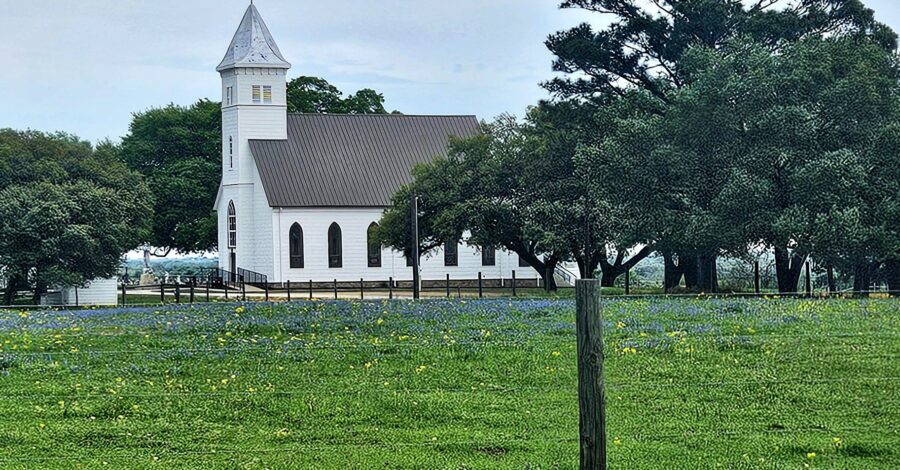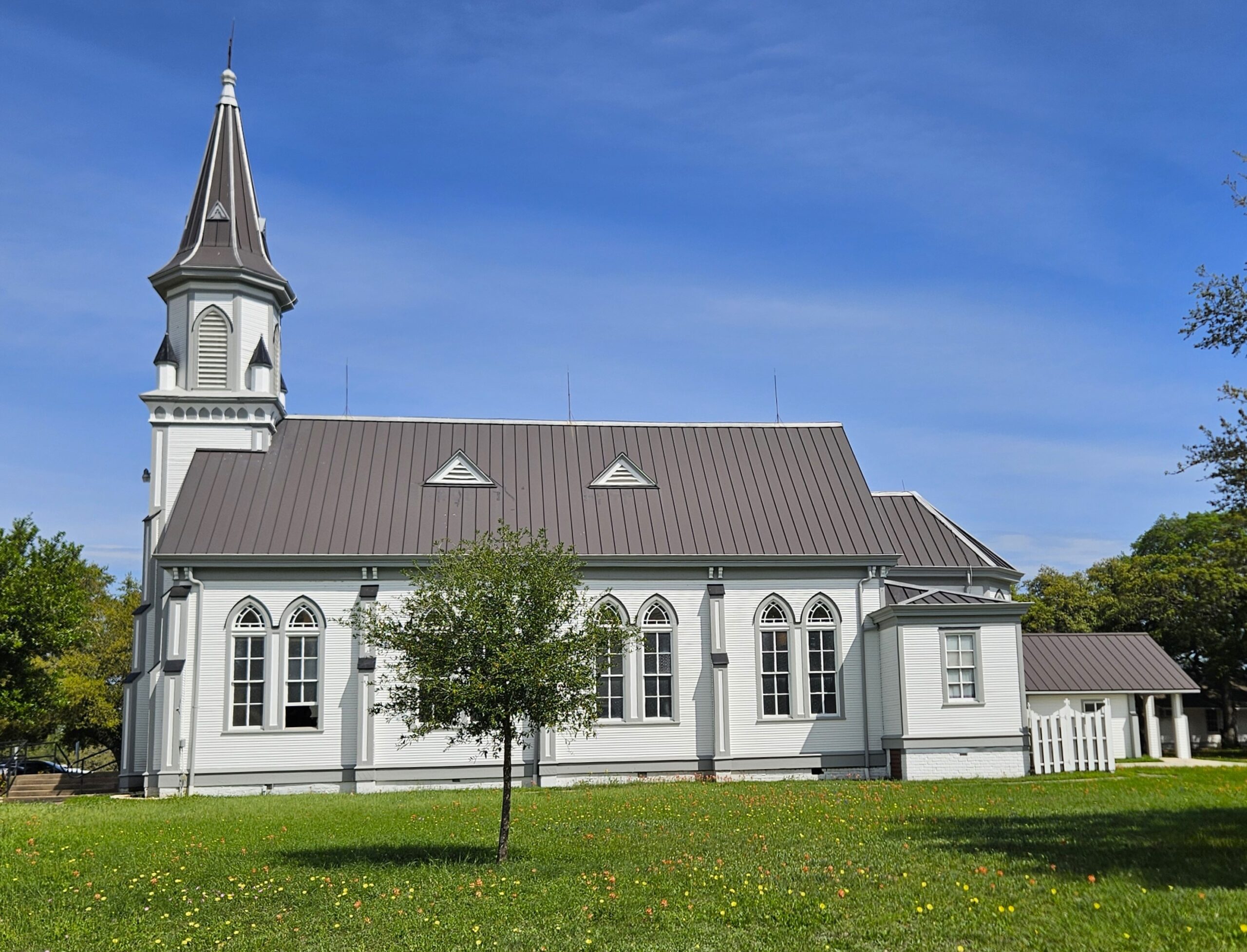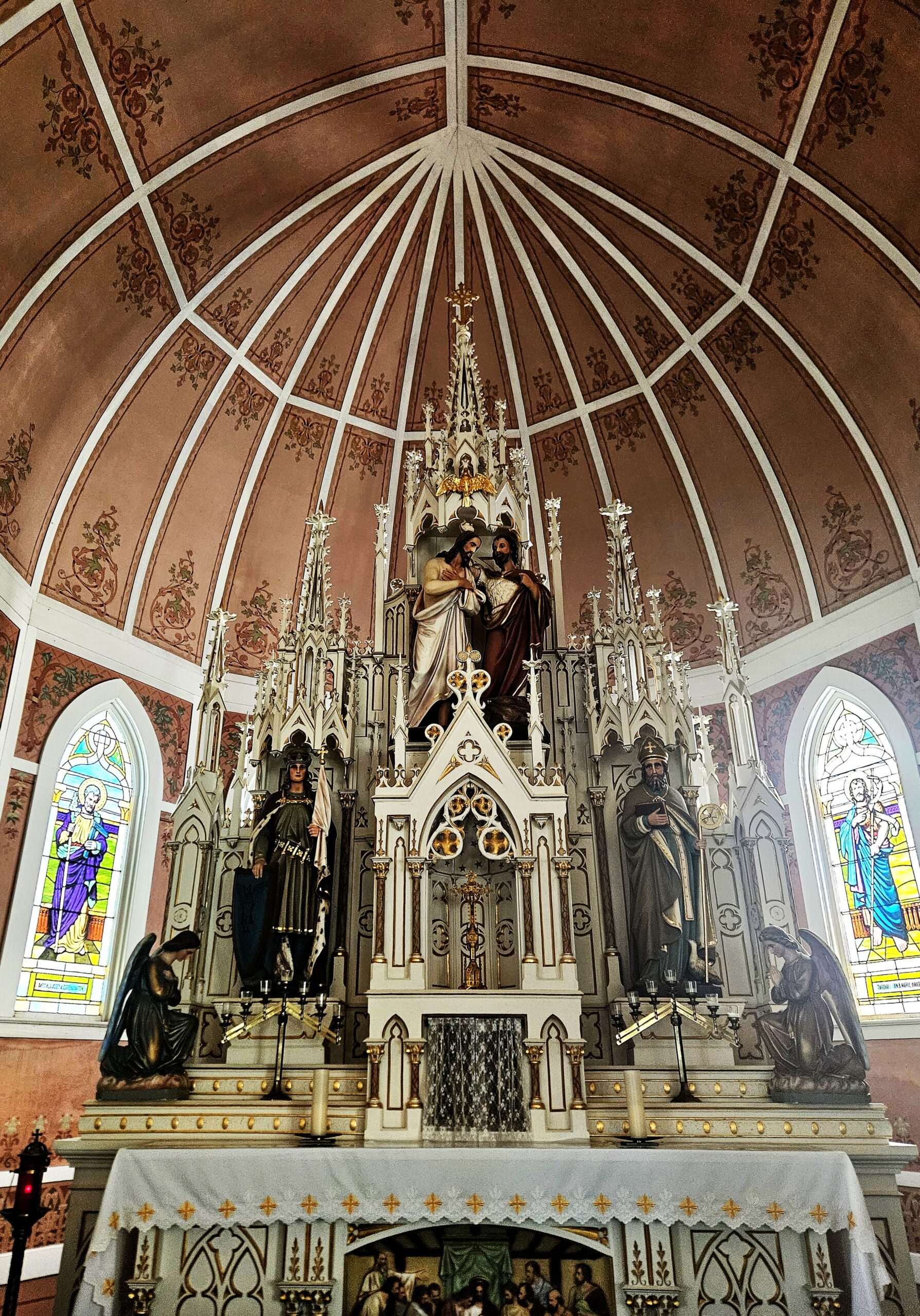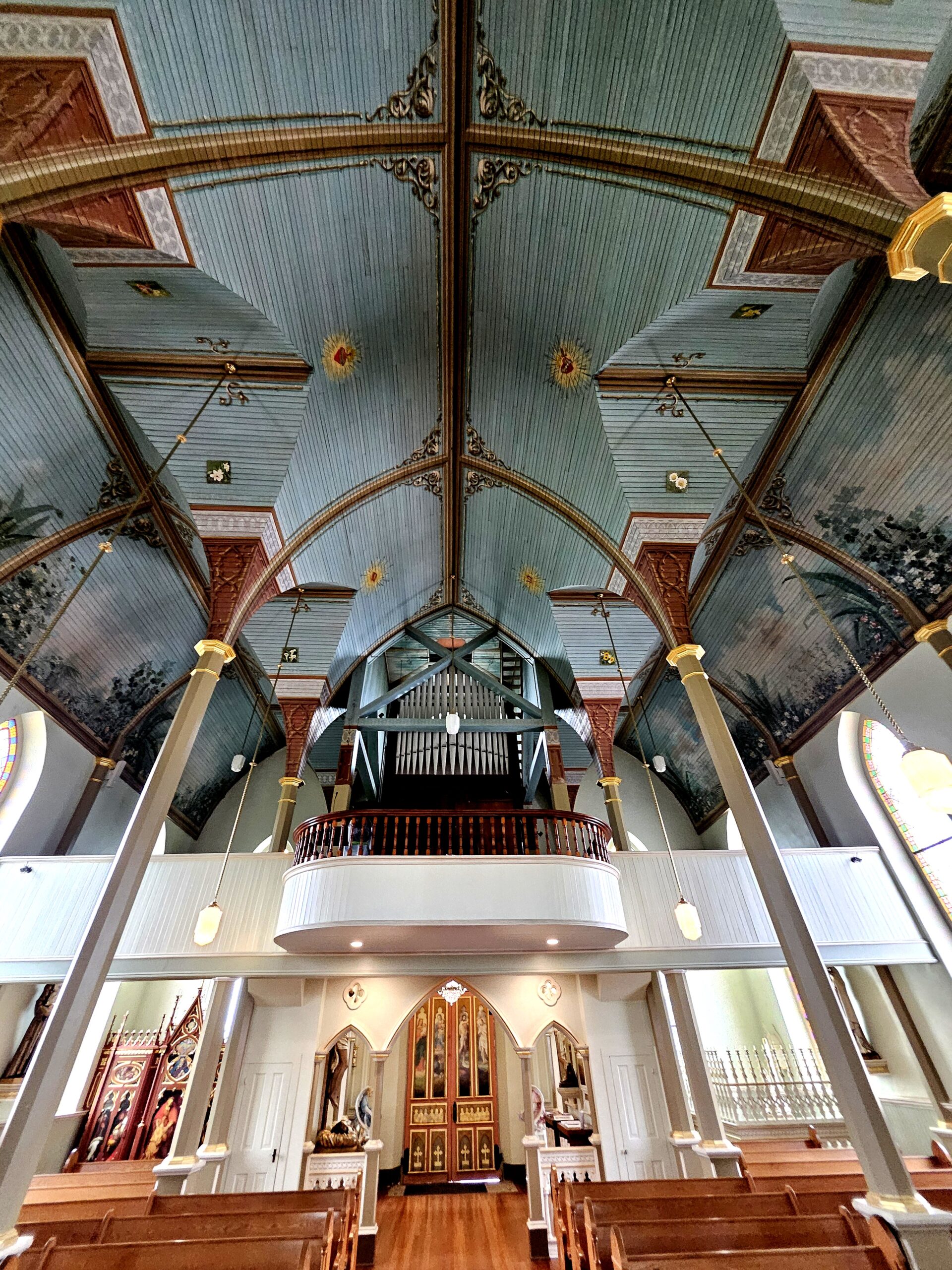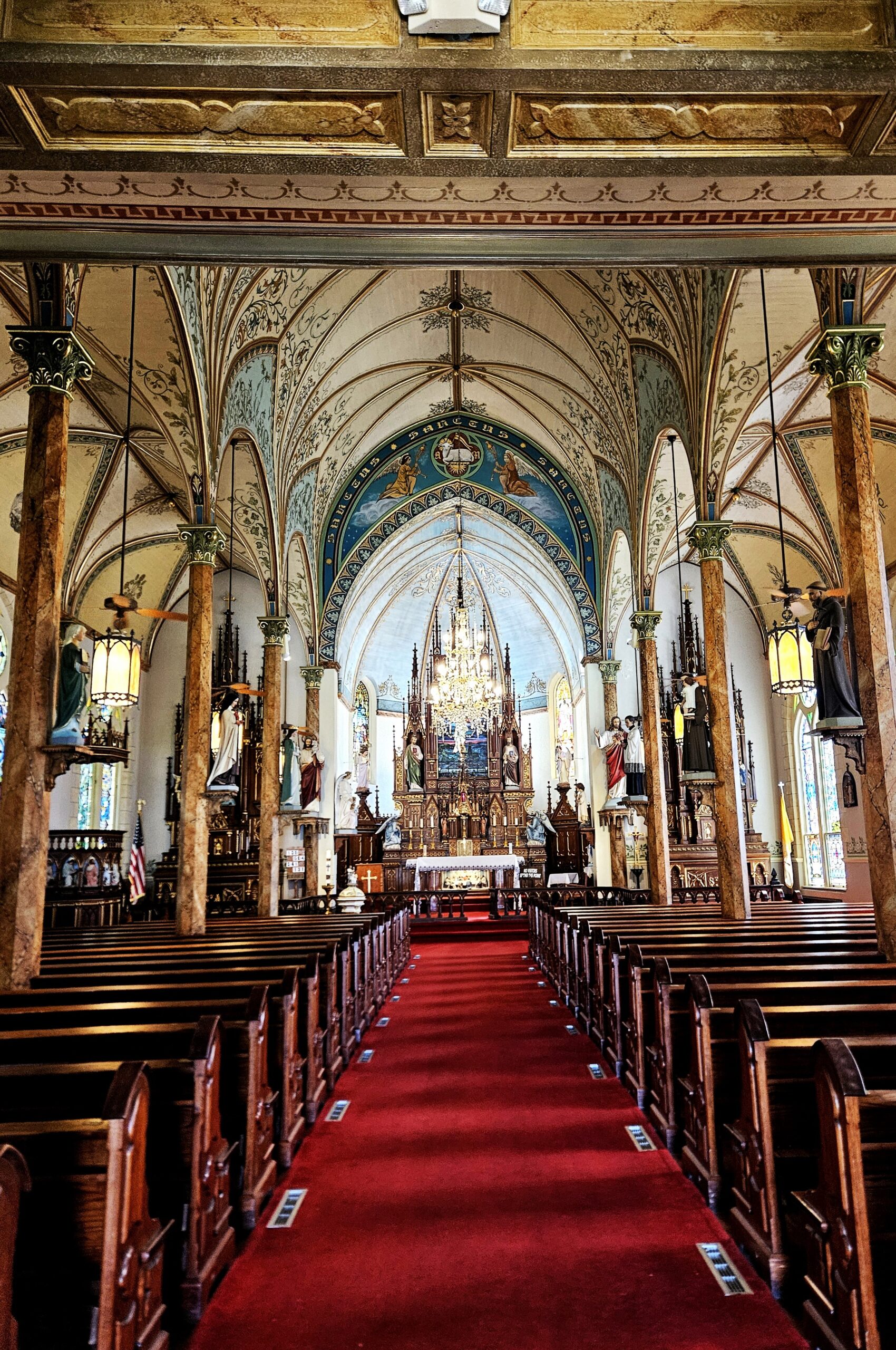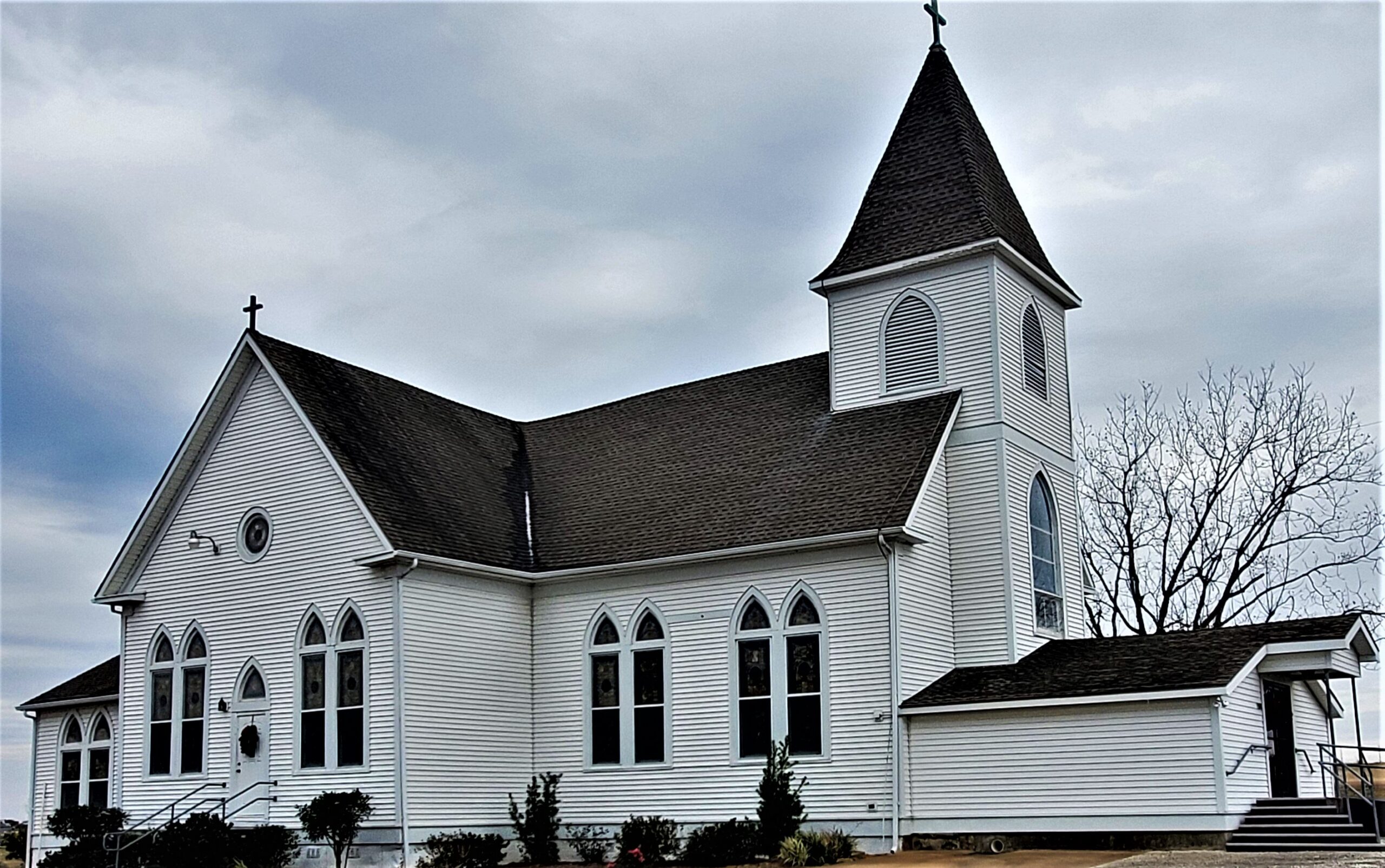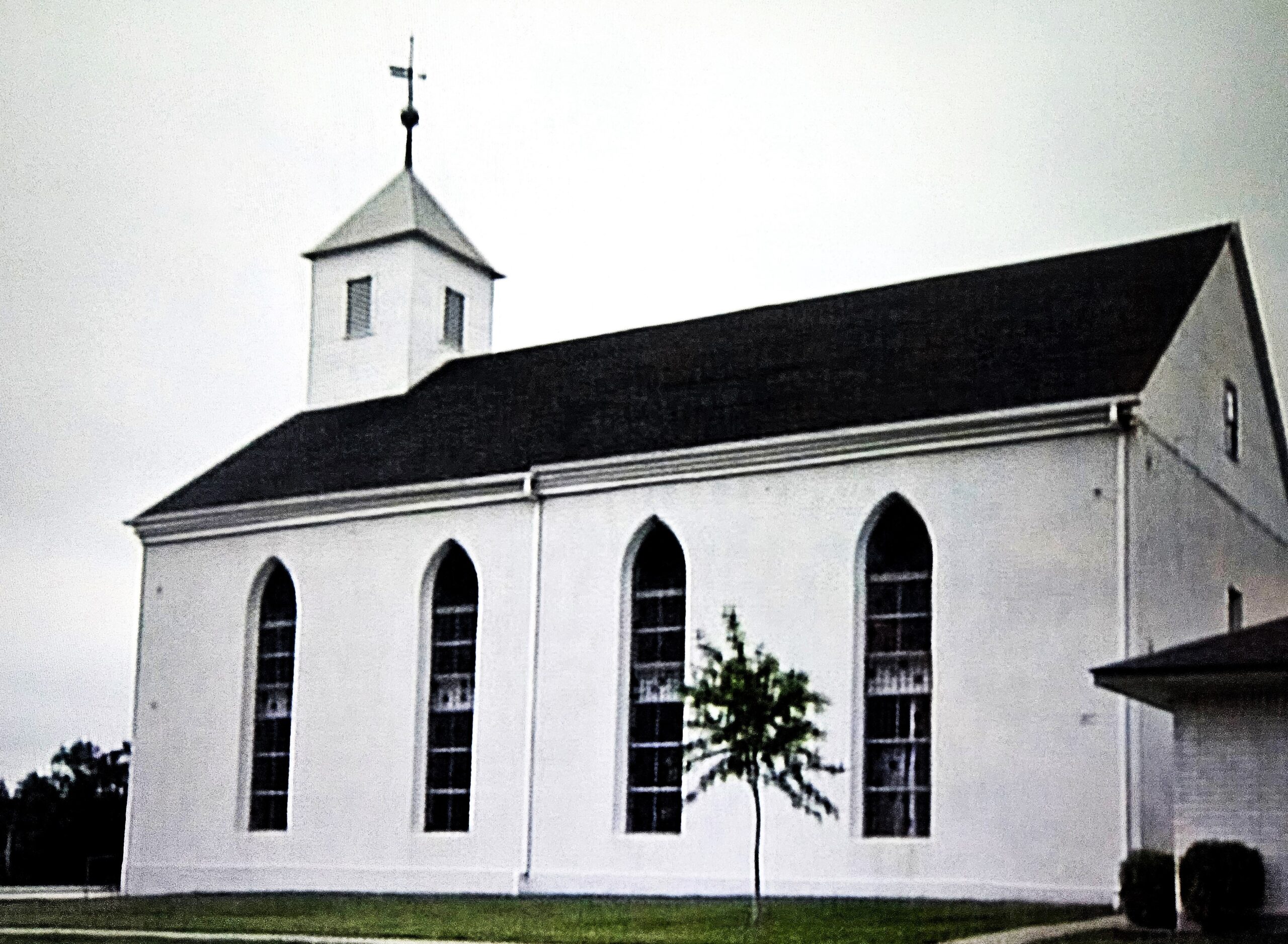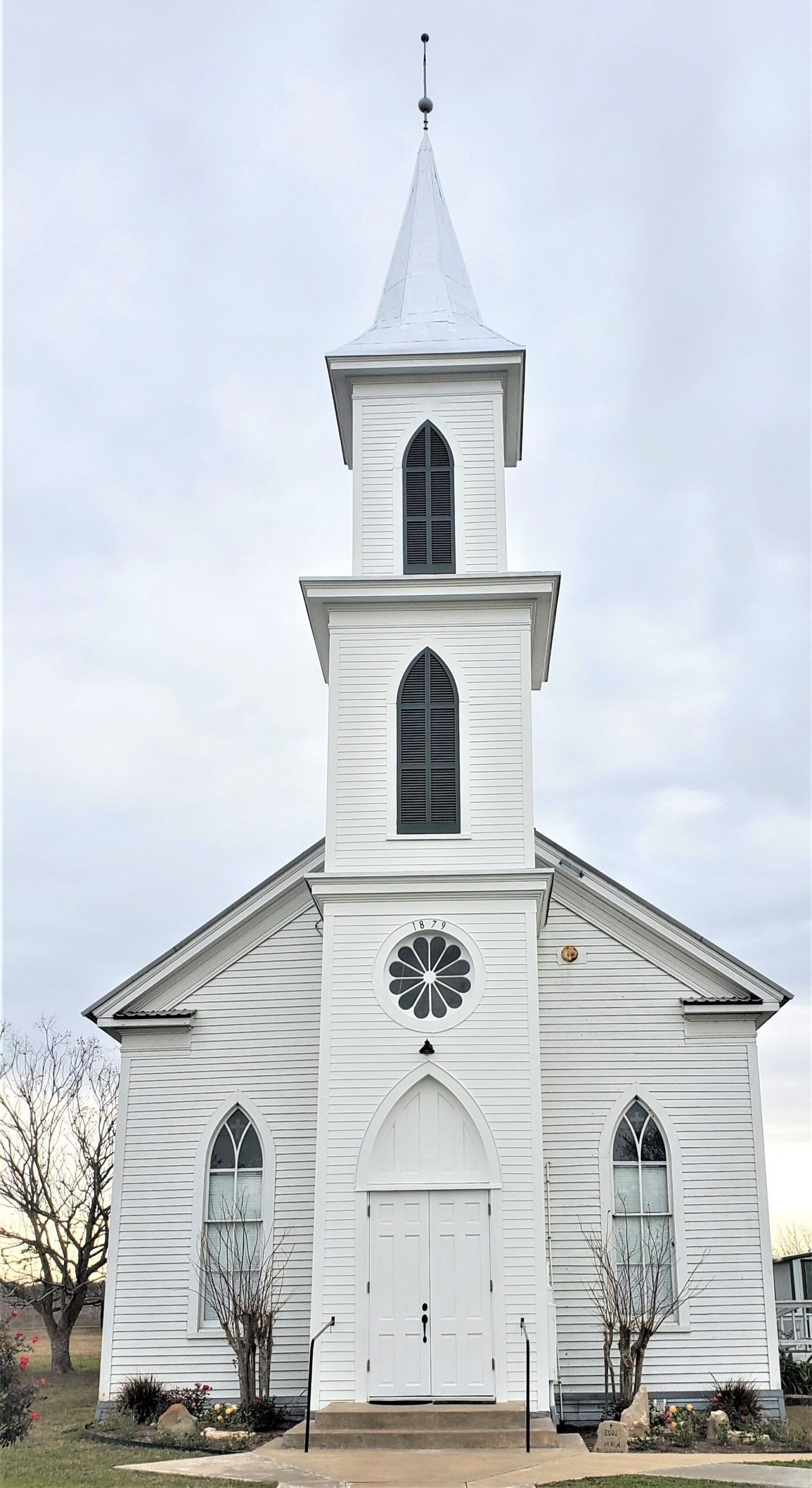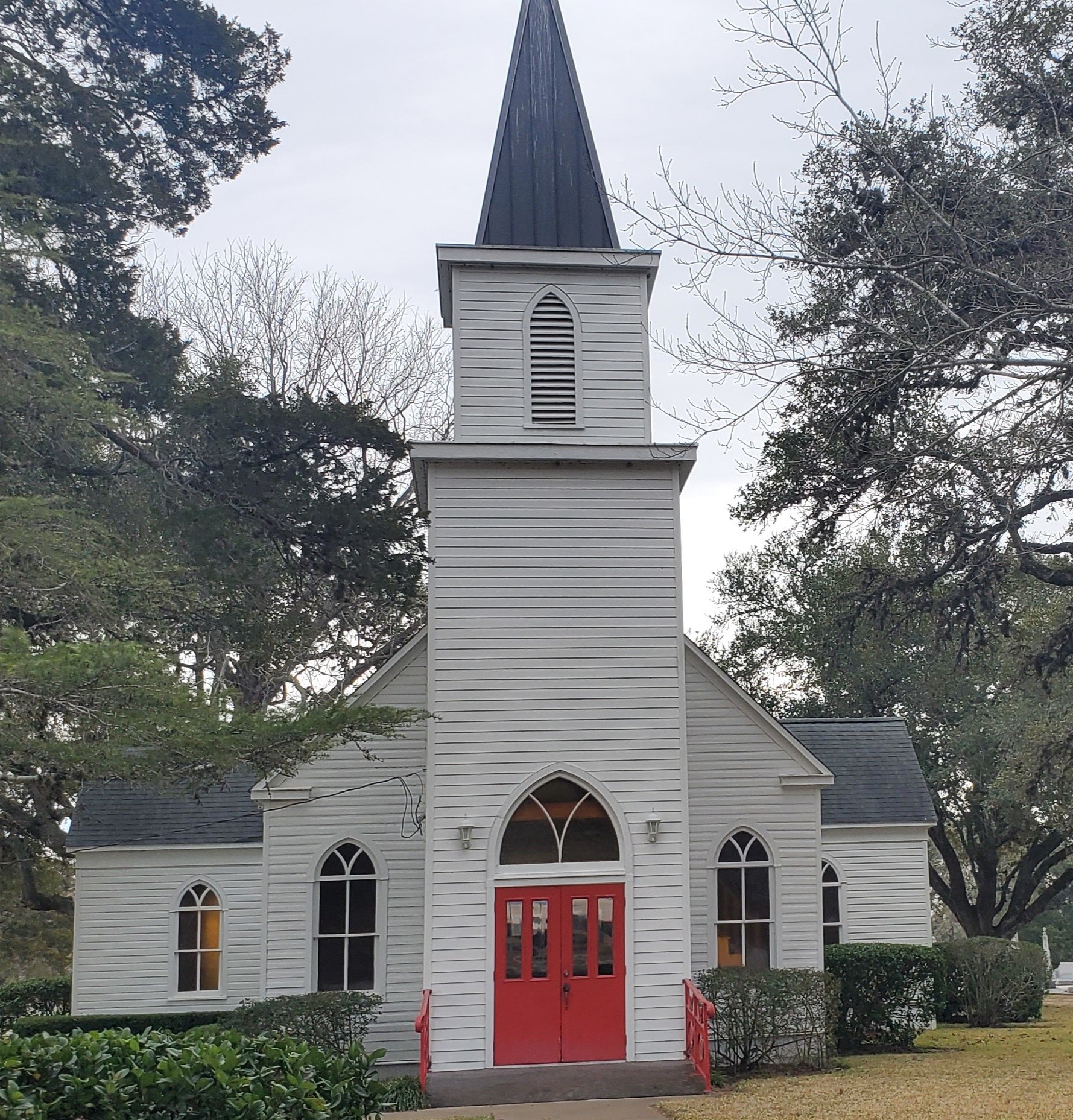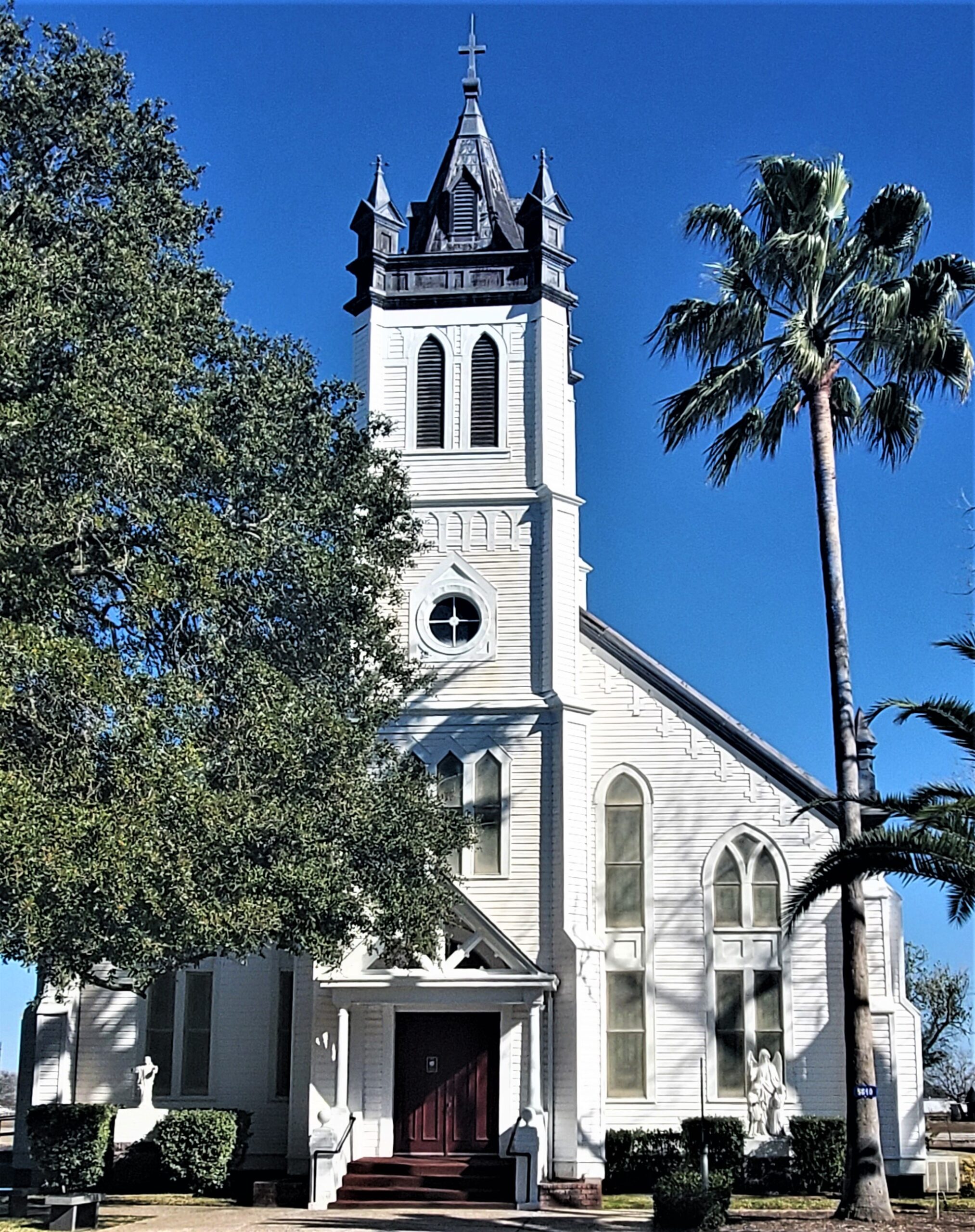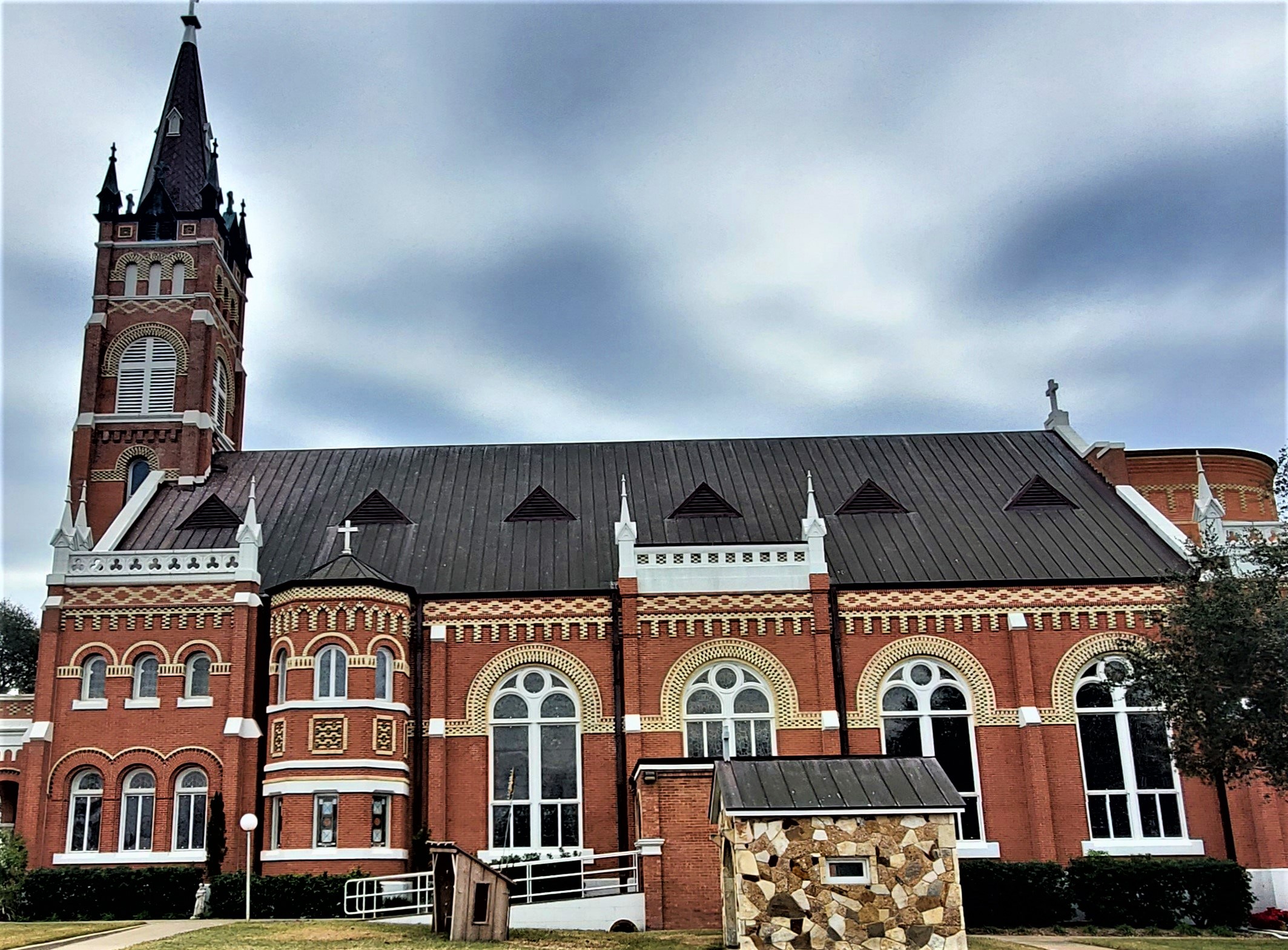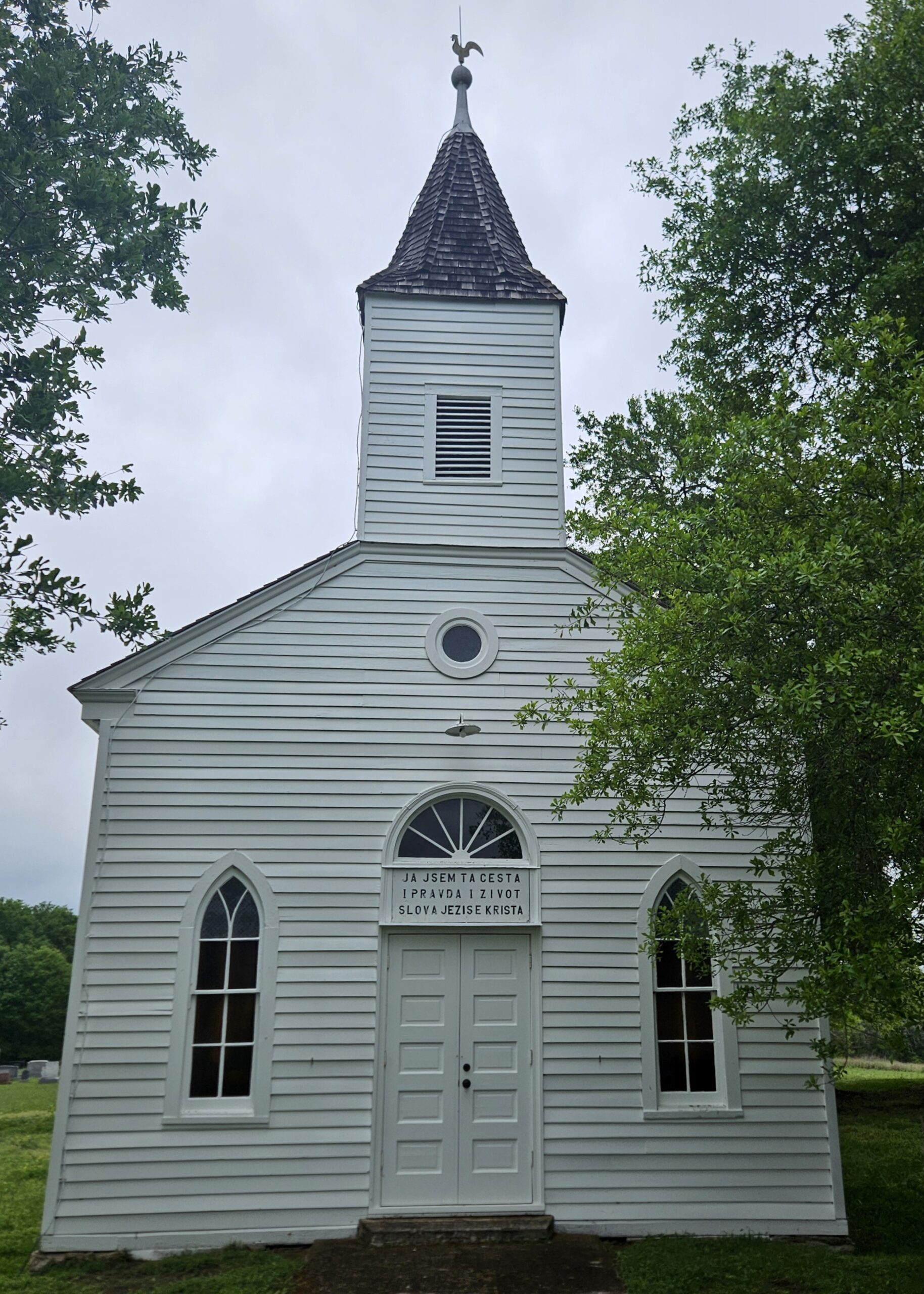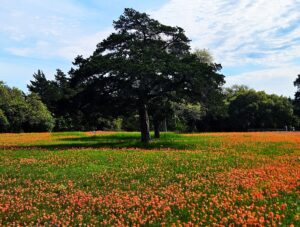 Schulenburg, Texas is the Home of the Painted Churches. These places of worship are open to the public in the communities of High Hill, Dubina, Praha and Ammannsville. Other churches are open for guided tours only. I first came to this lovely section of Texas in 2021 and was so taken with these spectacular interiors that I had to return again during the wildflower season to experience the dazzling bluebonnets, along with over 20 other types of flowers that brilliantly carpet the fields and line the highways. These are not the only painted churches in Texas. Over 30 are scattered throughout the state, but some of the most memorable are in and around Schulenburg. I have updated the original article with one more church, more detail and with even better photos.
Schulenburg, Texas is the Home of the Painted Churches. These places of worship are open to the public in the communities of High Hill, Dubina, Praha and Ammannsville. Other churches are open for guided tours only. I first came to this lovely section of Texas in 2021 and was so taken with these spectacular interiors that I had to return again during the wildflower season to experience the dazzling bluebonnets, along with over 20 other types of flowers that brilliantly carpet the fields and line the highways. These are not the only painted churches in Texas. Over 30 are scattered throughout the state, but some of the most memorable are in and around Schulenburg. I have updated the original article with one more church, more detail and with even better photos.
Texas has long had a significant Central European influence. German, Czech, Austrian and Swiss immigrants landed in Galveston during the 19th century and migrated west to central Texas with hopes of securing inexpensive farmland and practicing their faith.
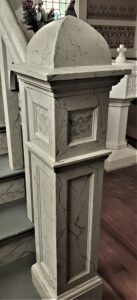 Part of their legacy is The Painted Churches of Texas. The fresh arrivals, struggling to establish new lives while preserving their cultural identity, built these churches in their communities. They could not reproduce the grand cathedrals and churches of their homelands. Instead, they erected wooden churches and painted the interiors in an elaborate style. In many of the interiors they rendered with paint and wood the architectural details of stonework that they could not build. The exteriors of many of these structures are very simple but their interiors are masterworks of visual painted texture and color.
Part of their legacy is The Painted Churches of Texas. The fresh arrivals, struggling to establish new lives while preserving their cultural identity, built these churches in their communities. They could not reproduce the grand cathedrals and churches of their homelands. Instead, they erected wooden churches and painted the interiors in an elaborate style. In many of the interiors they rendered with paint and wood the architectural details of stonework that they could not build. The exteriors of many of these structures are very simple but their interiors are masterworks of visual painted texture and color.
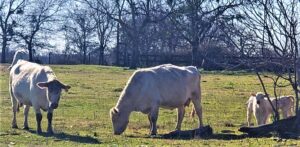
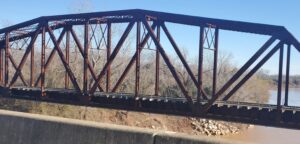 Our hunt began with the ten of the best-known churches in or near Schulenburg. These churches are out in the middle of farm and cattle lands on the Texas prairie. It is hard to imagine such grand structures in the sparsely populated areas. Because of the flat landscape you can see their beckoning steeples for miles before you arrive.
Our hunt began with the ten of the best-known churches in or near Schulenburg. These churches are out in the middle of farm and cattle lands on the Texas prairie. It is hard to imagine such grand structures in the sparsely populated areas. Because of the flat landscape you can see their beckoning steeples for miles before you arrive. 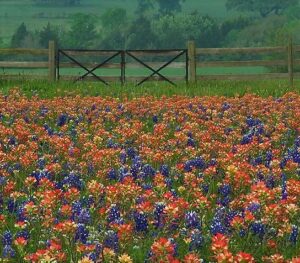
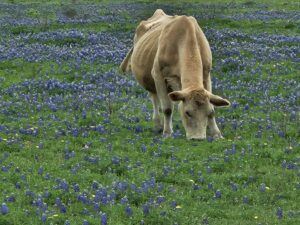 The town of Schulenburg is recognized as the official home of the painted churches. Many historic sites and markers are scattered around this charming area. This region is especially appealing in the spring when the blue bonnets and paintbrush wildflowers are in full bloom.
The town of Schulenburg is recognized as the official home of the painted churches. Many historic sites and markers are scattered around this charming area. This region is especially appealing in the spring when the blue bonnets and paintbrush wildflowers are in full bloom.
Dubina Parish Church
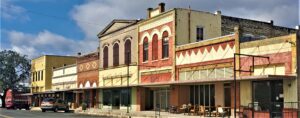
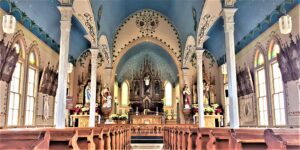 We began our tour in Dubina. Dubina was the first settlement in Texas founded entirely by Czech-Moravians. They were some of the earliest families in Texas who left the Austro-Hungarian Empire by boat landing in Galveston. They named the town for the many oak trees in the area (the Czech word for oak grove is “dubina”).
We began our tour in Dubina. Dubina was the first settlement in Texas founded entirely by Czech-Moravians. They were some of the earliest families in Texas who left the Austro-Hungarian Empire by boat landing in Galveston. They named the town for the many oak trees in the area (the Czech word for oak grove is “dubina”). 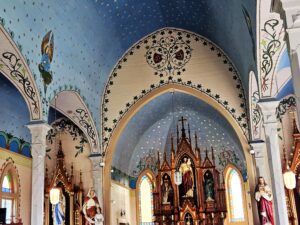 The Dubina Parish Church was built in 1877 but lost in the Velasco hurricane of 1909. The present church was erected in 1912 as the Cyril & Methodius Catholic Church.
The Dubina Parish Church was built in 1877 but lost in the Velasco hurricane of 1909. The present church was erected in 1912 as the Cyril & Methodius Catholic Church. 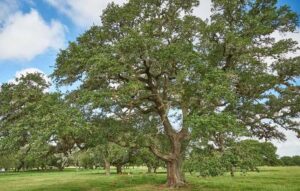
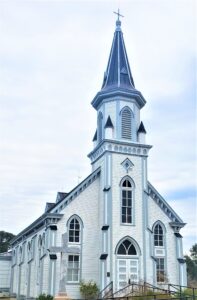 This Church is a Carpenter Gothic design – a Gothic Revival Style which emulates with wood features that were originally carved in stone in Gothic Architecture.It is painted inside with stencils and fresco. The forged cross which adorns the steeple is from the original church, and forged by Tom Lee, a blacksmith who was a freed slave.
This Church is a Carpenter Gothic design – a Gothic Revival Style which emulates with wood features that were originally carved in stone in Gothic Architecture.It is painted inside with stencils and fresco. The forged cross which adorns the steeple is from the original church, and forged by Tom Lee, a blacksmith who was a freed slave.
Ammannsville St John the Baptist Church
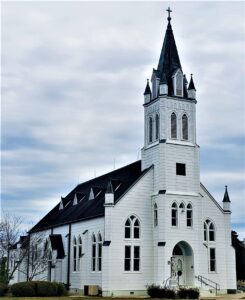
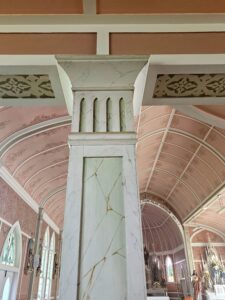
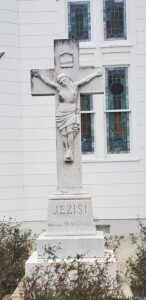 Ammannsville was established in 1870 by Andrew Ammann and his family. Until 1890 the townspeople had to travel out of town to attend a religious service. Then, the church was built and dedicated to John the Baptist. As in Dubina, the church perished in the Velasco hurricane. The congregation opted to rebuild the church in a decorative Victorian style, but the new church burned to its foundations. Only a few statues from the original churched survived and are displayed in the current church. In 1917 the present church, known as the pink church because of its rose colored interior, was built on the same site. Faux marble painted wood columns support a beautifully stenciled ceiling. It is once believed that the existing interior was painted by a European drifter who stenciled and marbled in freehand, but the work is now attributed to Fred Donneker a decorative painter of the time. It is one of the most striking interiors of all of the churches.
Ammannsville was established in 1870 by Andrew Ammann and his family. Until 1890 the townspeople had to travel out of town to attend a religious service. Then, the church was built and dedicated to John the Baptist. As in Dubina, the church perished in the Velasco hurricane. The congregation opted to rebuild the church in a decorative Victorian style, but the new church burned to its foundations. Only a few statues from the original churched survived and are displayed in the current church. In 1917 the present church, known as the pink church because of its rose colored interior, was built on the same site. Faux marble painted wood columns support a beautifully stenciled ceiling. It is once believed that the existing interior was painted by a European drifter who stenciled and marbled in freehand, but the work is now attributed to Fred Donneker a decorative painter of the time. It is one of the most striking interiors of all of the churches.
Praha The Assumption of the Blessed Virgin Mary
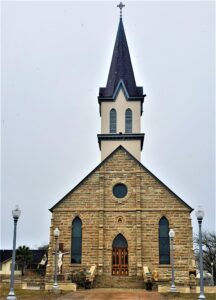
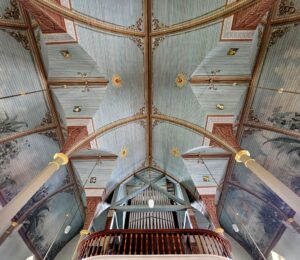 The town of Praha was originally known as Mulberry, for the creek in the area where Czech-Moravian immigrants settled in in 1854. The name Praha, the Czech spelling for Prague, was given to the town years later. The church was built and dedicated under the name The Assumption of the Blessed Virgin Mary and is often referred to as St Mary’s.
The town of Praha was originally known as Mulberry, for the creek in the area where Czech-Moravian immigrants settled in in 1854. The name Praha, the Czech spelling for Prague, was given to the town years later. The church was built and dedicated under the name The Assumption of the Blessed Virgin Mary and is often referred to as St Mary’s. 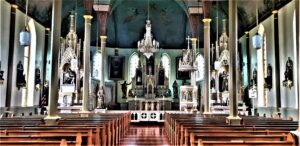 A well-known Swiss Artist Gottfried Flury, who lived in the area, painted the colorful vaulted ceiling. The ceiling has not changed from the day it was painted in 1895, and never retouched. The Praha cemetery next to the church was dedicated in 1865. Praha has a huge gathering every August for the Assumption of Mary when thousands descend on the church grounds for a homecoming celebration.
A well-known Swiss Artist Gottfried Flury, who lived in the area, painted the colorful vaulted ceiling. The ceiling has not changed from the day it was painted in 1895, and never retouched. The Praha cemetery next to the church was dedicated in 1865. Praha has a huge gathering every August for the Assumption of Mary when thousands descend on the church grounds for a homecoming celebration.
High Hill St Mary’s Catholic Church
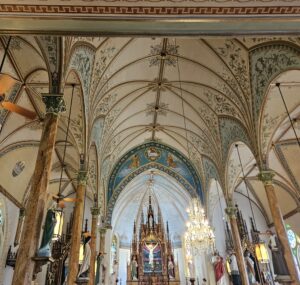
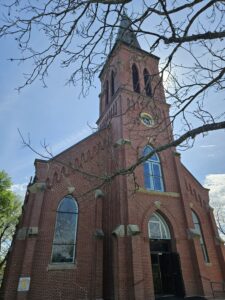 High Hill was first established in the mid-1800s by German and Austrian settlers. Originally called “Blum Hill” it was once a stagecoach stop until a train was routed through the area in 1874. There have been three churches built on this site.
High Hill was first established in the mid-1800s by German and Austrian settlers. Originally called “Blum Hill” it was once a stagecoach stop until a train was routed through the area in 1874. There have been three churches built on this site. 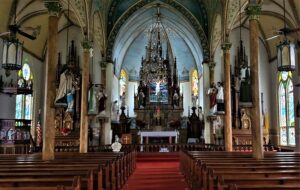 The current church The Nativity of the Blessed Virgin Mary Catholic Church was constructed in 1908 and painted six years later. It is a Gothic Revival design with a late Victorian twist. It is known as the “Queen of the Painted Churches” due to its brilliant color, dynamic stained glass windows. Eighteen original windows from the second church were placed in the current church. The wooden columns are painted with turkey feathers to look like marble. It has a highly-crafted altar, chandelier, and pipe organ. The Stations of the Cross were made in Italy as was a hand-painted replica of Michelangelo’s “Pieta.”
The current church The Nativity of the Blessed Virgin Mary Catholic Church was constructed in 1908 and painted six years later. It is a Gothic Revival design with a late Victorian twist. It is known as the “Queen of the Painted Churches” due to its brilliant color, dynamic stained glass windows. Eighteen original windows from the second church were placed in the current church. The wooden columns are painted with turkey feathers to look like marble. It has a highly-crafted altar, chandelier, and pipe organ. The Stations of the Cross were made in Italy as was a hand-painted replica of Michelangelo’s “Pieta.”
Moravia The Ascension of Our Lord Catholic Church
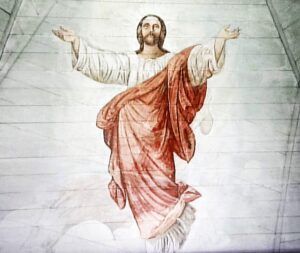
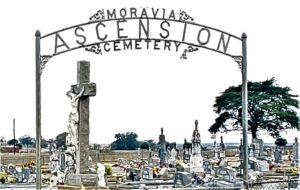 In the 1870s a wave of immigrants from Moravia Czechoslovakia arrived in Texas. To honor their homeland they named the area Moravia. With these “New Texans” came their unique customs, language and culture. Even now many the Moravians still speak the Czech language as well as English. The Ascension of Our Lord Catholic Church of Moravia was built in 1912, designed by its first pastor Emil Schindler. The interior colors are more subtle than in neighboring churches. A large painting behind the altar represents Christ ascending with the angels.
In the 1870s a wave of immigrants from Moravia Czechoslovakia arrived in Texas. To honor their homeland they named the area Moravia. With these “New Texans” came their unique customs, language and culture. Even now many the Moravians still speak the Czech language as well as English. The Ascension of Our Lord Catholic Church of Moravia was built in 1912, designed by its first pastor Emil Schindler. The interior colors are more subtle than in neighboring churches. A large painting behind the altar represents Christ ascending with the angels.
Serbin- St Pauls Lutheran Church
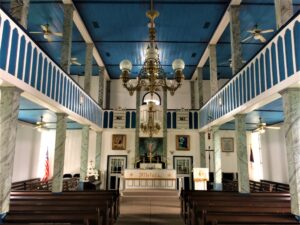
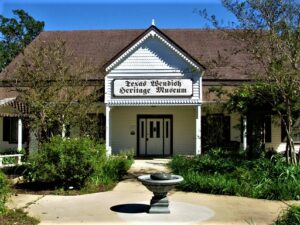 Also in the 1870s a group of Wendish people from Germany, arrived in central Texas. They built the Saint Paul’s Lutheran Church in Serbin, Texas. The Wends have their own unique culture and language, and the church they created reveals their culture and traditions. One of their customs was to seat the women and children below on the main level and the men in the balcony during the church service. Men and women sat apart. In ancient times the practice was referred to as a “matrimonium,” this custom lasted until World War II. Now, the entire congregation sits together. The style and decoration of this church is very simple. Its colors are a crisp blue and white. The balcony pulpit is allegedly the highest in Texas. There is also a Wendish Heritage Museum nearby.
Also in the 1870s a group of Wendish people from Germany, arrived in central Texas. They built the Saint Paul’s Lutheran Church in Serbin, Texas. The Wends have their own unique culture and language, and the church they created reveals their culture and traditions. One of their customs was to seat the women and children below on the main level and the men in the balcony during the church service. Men and women sat apart. In ancient times the practice was referred to as a “matrimonium,” this custom lasted until World War II. Now, the entire congregation sits together. The style and decoration of this church is very simple. Its colors are a crisp blue and white. The balcony pulpit is allegedly the highest in Texas. There is also a Wendish Heritage Museum nearby.
Freyburg
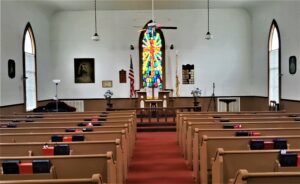 Freyburg was founded in the 1860s by German settlers, it was named for a town in the old country. The newcomers established both Lutheran and Methodist churches. The Lutheran church later moved and combined with the Swiss Alp church but the Methodist remained in the same space since its completion in 1879. The interior is simple and contains the original altar and benches.
Freyburg was founded in the 1860s by German settlers, it was named for a town in the old country. The newcomers established both Lutheran and Methodist churches. The Lutheran church later moved and combined with the Swiss Alp church but the Methodist remained in the same space since its completion in 1879. The interior is simple and contains the original altar and benches.
Philadelphia Evangelical Lutheran Church-Swiss Alp
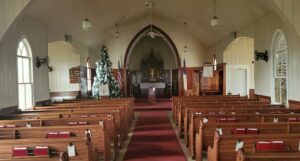 German Lutherans arrived to settle in Swiss Alp at the close of the Civil War in 1865. The small population was augmented by Wends who arrived a year later from Serbin in Lee County. The Philadelphia Evangelical Lutheran Church emerged as an organized congregation in 1867 that met in local homes for services until a church could be built. The Church was dedicated in 1890 followed by a church bell in 1891. The interior is subdued and simple.
German Lutherans arrived to settle in Swiss Alp at the close of the Civil War in 1865. The small population was augmented by Wends who arrived a year later from Serbin in Lee County. The Philadelphia Evangelical Lutheran Church emerged as an organized congregation in 1867 that met in local homes for services until a church could be built. The Church was dedicated in 1890 followed by a church bell in 1891. The interior is subdued and simple.
Guardian Angel Catholic Church in Wallis
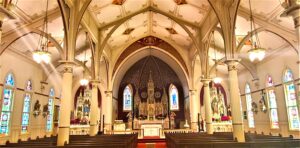 Guardian Angel Catholic Church in Wallis is one of the last Painted Churches built in Texas. It is a Roman Catholic Church of Gothic Revival design completed in 1915. The leaded glass windows were imported from Italy. There are three brass bells in the tower.
Guardian Angel Catholic Church in Wallis is one of the last Painted Churches built in Texas. It is a Roman Catholic Church of Gothic Revival design completed in 1915. The leaded glass windows were imported from Italy. There are three brass bells in the tower.
Saint Cyril and Methodius Catholic Church
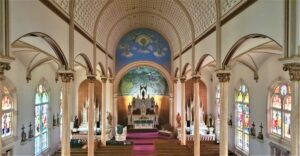
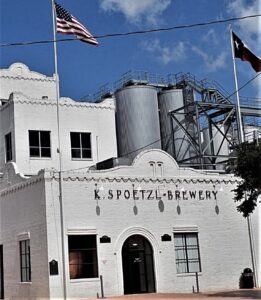 A half a hour outside Schulenburg in Shiner stands the Saint Cyril and Methodius Catholic Church. It is a grand red brick building with an interior of Romanesque Revival Style. Above the alter is a dramatically colorful mural of Christ in the Garden of Gethsemane. It was dedicated in 1921. Also of interest in Shiner is the Spoetzel Brewery which brews Shiner Beer.
A half a hour outside Schulenburg in Shiner stands the Saint Cyril and Methodius Catholic Church. It is a grand red brick building with an interior of Romanesque Revival Style. Above the alter is a dramatically colorful mural of Christ in the Garden of Gethsemane. It was dedicated in 1921. Also of interest in Shiner is the Spoetzel Brewery which brews Shiner Beer.
Wesley Brethren Church
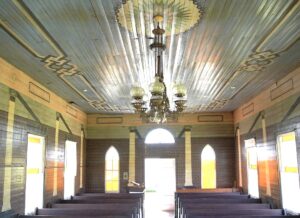 Built in 1866 and painted in 1889, this church is tiny! Czech immigrant pastor Reverend Bohuslav Laciak painted it. It was used as a schoolhouse and the reverend was the teacher. Laciak was often up the ladder painting as the children studied. Legend has it that the faux bricks he painted were suppose to represent the walls of old Jerusalem. Unfortunately he was accidentally shot in a hunting accident- the walls and ceiling remain untouched and unfinished you can still see the sketches he had yet to paint.
Built in 1866 and painted in 1889, this church is tiny! Czech immigrant pastor Reverend Bohuslav Laciak painted it. It was used as a schoolhouse and the reverend was the teacher. Laciak was often up the ladder painting as the children studied. Legend has it that the faux bricks he painted were suppose to represent the walls of old Jerusalem. Unfortunately he was accidentally shot in a hunting accident- the walls and ceiling remain untouched and unfinished you can still see the sketches he had yet to paint.
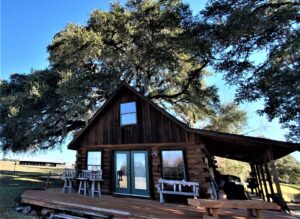
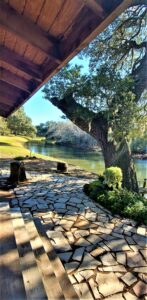
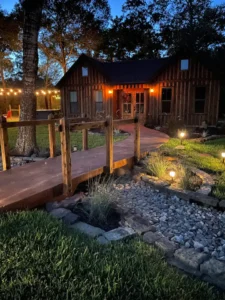
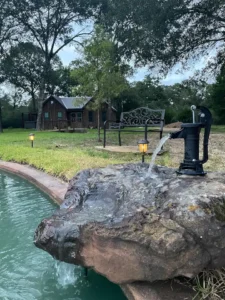 We found a peaceful place to stay near The Painted Churches, “Still Waters” in Weimar is a cabin set next to a beautifully, placid one acre lake. It is a pastoral setting with the lake on one side and cows grazing on the other side. Above and next to the house are ancient oaks which cradle the cabin and are loaded with an assortment of song birds. You can find this cabin rental on Airbnb. We have also stayed at Fawn Creek also in Weimar which was a great escape nestled in the woods with a pond out front.
We found a peaceful place to stay near The Painted Churches, “Still Waters” in Weimar is a cabin set next to a beautifully, placid one acre lake. It is a pastoral setting with the lake on one side and cows grazing on the other side. Above and next to the house are ancient oaks which cradle the cabin and are loaded with an assortment of song birds. You can find this cabin rental on Airbnb. We have also stayed at Fawn Creek also in Weimar which was a great escape nestled in the woods with a pond out front. 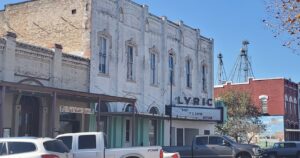 It is a sanctuary of peace and the hosts have thought of everything imaginable for your comfort. It is also very close to Schulenburg and the painted churches! Another discovery in this area is a restaurant in downtown Flatonia called “ The Red Vault Bistro”. It is located in a vintage building that is over a hundred years old. The food selection and setting are outstanding and the prices are reasonable for the quality of the food.
It is a sanctuary of peace and the hosts have thought of everything imaginable for your comfort. It is also very close to Schulenburg and the painted churches! Another discovery in this area is a restaurant in downtown Flatonia called “ The Red Vault Bistro”. It is located in a vintage building that is over a hundred years old. The food selection and setting are outstanding and the prices are reasonable for the quality of the food.
This section of Texas is rich with a blending of cultures. The impact of the immigrants over the years fused with native Texan population to create a fascinating diversity in heritage and history. This has impacted the architecture, art and food of this region and has created unique historical towns. From the rolling prairie, to the farms, to the cattle ranches, and in the spring the explosion of wildflowers, this region will surprise you and so will these remarkable churches!

